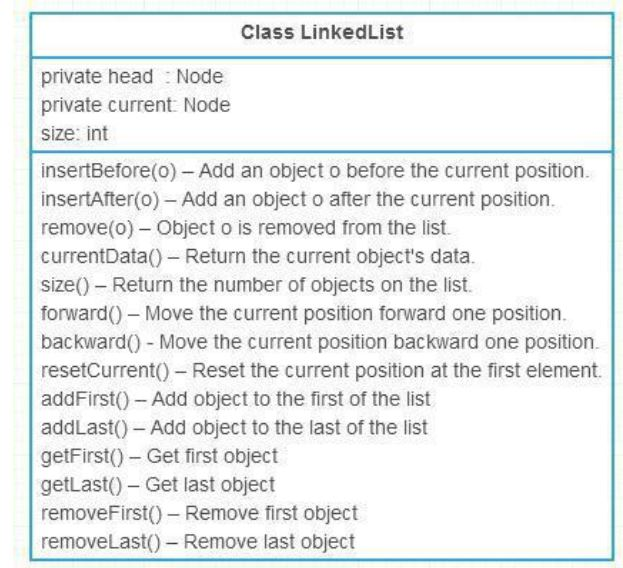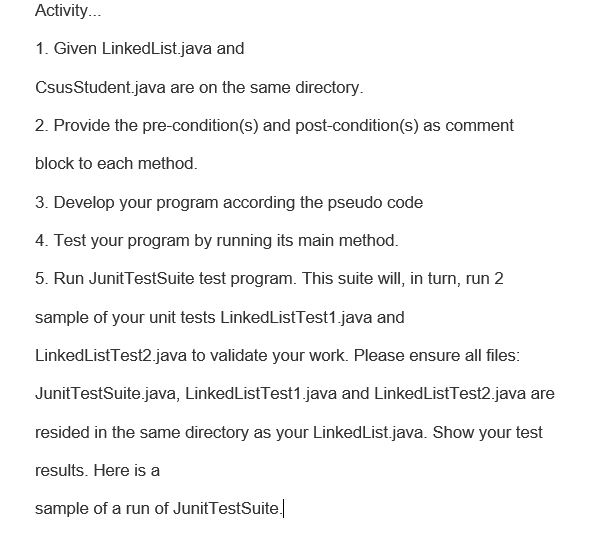Question
/************************************* LinkedList.java ****************************************/ // Fill in code in ALL commented areas public class LinkedList { // Defined Node class private class Node { private Object



/************************************* LinkedList.java ****************************************/
// Fill in code in ALL commented areas
public class LinkedList {
// Defined Node class
private class Node {
private Object Data = null;
private Node Next = null;
public Node() {
Data = null;
Next = null;
}
public Node(Object element) {
Data = element;
}
public Node(Object o, Node n) {
Data = o;
Next = n;
}
public void setNext(Node n) {
Next = n;
}
public Node getNext() {
return Next;
}
public Object getElement() {
return Data;
}
public void setElement(Object element) {
Data = element;
}
}
// Internal data for LinkedList
private Node head = null;
private Node current = null;
private int size = 0;
// LinkedList constructor
public LinkedList() {
head = null;
current = head;
}
// Move the current position forward one position
public void forward() {
}
// Move the current position backward one position
public void backward() {
}
// Get current object's data element
public Object currentData() {
}
// Add object to the first of the list
public void addFirst(Object o) {
}
// resetCurrent at the first position
public void resetCurrent() {
}
// Add object to the last of the list
public void addLast(Object o) {
}
// Add an object o before the current position
public void insertBefore(Object o) {
}
// Add an object o after the current position
public void insertAfter(Object o) {
}
// Get first object
public Object getFirst() {
}
// Get last object
public Object getLast() {
}
// Remove the first object
public Object removeFirst(){
}
// Remove the last object
public Object removeLast() {
}
// Remove object o from the list
public void remove(Object o) {
}
// Returns the number of elements on the list
public int size() {
return size;
}
// Is the list emptied?
public boolean isEmpty() {
}
// Display a content of a list
public String toString() {
String r = "( HEAD -> ";
// Node l = head.getNext();
Node l = head;
while (l != null) {
r = r + l.getElement() + " -> " ;
l = l.getNext();
}
return r + " )";
}
public static void main(String args[]) {
LinkedList lst = new LinkedList();
// creat instances for testing
CsusStudent instance1 = new CsusStudent("John Doe 1", 1, "1
Somewhere", "916-555-1211", "johndoe1@somewhere.com");
CsusStudent instance2 = new CsusStudent("John Doe 2", 2, "2
Somewhere", "916-555-1212", "johndoe2@somewhere.com");
CsusStudent instance3 = new CsusStudent("John Doe 3", 3, "3
Somewhere", "916-555-1213", "johndoe3@somewhere.com");
CsusStudent instance4 = new CsusStudent("John Doe 4", 4, "4
Somewhere", "916-555-1214", "johndoe4@somewhere.com");
CsusStudent instance5 = new CsusStudent("John Doe 5", 5, "5
Somewhere", "916-555-1215", "johndoe5@somewhere.com");
CsusStudent instance6 = new CsusStudent("John Doe 6", 6, "6
Somewhere", "916-555-1216", "johndoe6@somewhere.com");
CsusStudent instance7 = new CsusStudent("John Doe 7", 7, "7
Somewhere", "916-555-1217", "johndoe7@somewhere.com");
CsusStudent instance8 = new CsusStudent("John Doe 8", 8, "8
Somewhere", "916-555-1218", "johndoe8@somewhere.com");
CsusStudent instance9 = new CsusStudent("John Doe 9", 9, "9
Somewhere", "916-555-1219", "johndoe9@somewhere.com");
// begin adding instance1 to the list
// test forward and backward for single entry
// now add instance2 and instance3 via addFirst and instance4,
instance5, instance6 via addLast
// move current forward a few times
// insert instance 9 after
// remove instance9
// print out the first and last entries
System.out.println("Show the first entry and last entry:");
// print out the whole list
System.out.println("Show the whole list:");
// remove entries starting from the last entry
System.out.println("Check for the content of the emptied list");
}
}
/********************************** CsusStudent.java *************************************************/
public class CsusStudent { // class attributes private String studentName; private int studentId; private String studentAddress; private String studentPhone; private String studentEmail; // constructor public CsusStudent(String newName, int newId, String newAddress, String newPhone_number, String newEmail){ this.studentName = newName; this.studentId = newId; this.studentAddress = newAddress; this.studentPhone = newPhone_number; this.studentEmail = newEmail; }
// setName public void setName(String newName){ this.studentName = newName; }
// getName public String getName(){ return studentName; } // setID public void setId(int newId){ this.studentId = newId; }
// getID public int getId(){ return studentId; }
// setAddress public void setAddress(String newAddress){ this.studentAddress = newAddress; }
// getAddress public String getAddress(){ return studentAddress; }
// setPhone public void setPhone(String newPhone_number){ this.studentPhone = newPhone_number; }
// getPhone public String getPhone(){ return studentPhone; }
// setEmail public void setEmail(String newEmail){ this.studentEmail = newEmail; }
// getEmail public String getEmail(){ return studentEmail; }
// toString public String toString() { return "studentName=" + studentName + ", studentId=" + studentId + ", studentAddress=" + studentAddress + ", studentPhone=" + studentPhone + ", studentEmail=" + studentEmail; } }
/************************************************************** LinkedListTest.java ********************************************************/
// Description: Test suite module to test LinkedListTest1 and
LinkedListTest2.
// Author: Doan Nguyen
// Date: 3/5/18 (Updated)
import org.junit.runner.RunWith;
import org.junit.runners.Suite;
import org.junit.Assert;
import static org.junit.Assert.*;
import org.junit.Before;
import org.junit.Test;
@RunWith(Suite.class)
@Suite.SuiteClasses({
LinkedListTest1.class,
LinkedListTest2.class
})
public class LinkedListTest {
}
/************************************************************** LinkedListTest1.java *********************************************/
// Description: Test module to test single linear linkedlist with
CsusStudent objects
// Author: Doan Nguyen
// Date: 1/8/18 (Updated)
import org.junit.Assert;
import static org.junit.Assert.*;
import org.junit.Before;
import org.junit.Test;
public class LinkedListTest1 {
/** Fixture initialization (common initialization
* for all tests). **/
CsusStudent instance1, instance2, instance3, instance4, instance5,
instance6, instance7, instance8;
@Before public void setUp() {
instance1 = new CsusStudent("John Doe 1", 1, "1 Somewhere", "916-
555-1211", "johndoe1@somewhere.com");
instance2 = new CsusStudent("John Doe 2", 2, "2 Somewhere", "916-
555-1212", "johndoe2@somewhere.com");
instance3 = new CsusStudent("John Doe 3", 3, "3 Somewhere", "916-
555-1213", "johndoe3@somewhere.com");
instance4 = new CsusStudent("John Doe 4", 4, "4 Somewhere", "916-
555-1214", "johndoe4@somewhere.com");
instance5 = new CsusStudent("John Doe 5", 5, "5 Somewhere", "916-
555-1215", "johndoe5@somewhere.com");
instance6 = new CsusStudent("John Doe 6", 6, "6 Somewhere", "916-
555-1216", "johndoe6@somewhere.com");
instance7 = new CsusStudent("John Doe 7", 7, "7 Somewhere", "916-
555-1217", "johndoe7@somewhere.com");
instance8 = new CsusStudent("John Doe 8", 8, "8 Somewhere", "916-
555-1218", "johndoe8@somewhere.com");
}
// test addFirst and getFirst
@Test public void testaddGetFirst() {
LinkedList lst = new LinkedList();
lst.addFirst(instance1);
int expResult = 1;
assertEquals(expResult, lst.size());
CsusStudent instance = (CsusStudent) lst.getFirst();
assertEquals("John Doe 1", instance.getName());
}
// test list traversal 1 with forward, getFirst, and getLast
@Test public void testTraversal1() {
LinkedList lst = new LinkedList();
lst.addFirst(instance1);
lst.addFirst(instance2);
lst.addFirst(instance3);
lst.addLast(instance4);
lst.addLast(instance5);
lst.addLast(instance6);
lst.forward();
lst.forward();
lst.insertAfter(instance7);
CsusStudent stf = (CsusStudent)lst.getFirst();
CsusStudent stl = (CsusStudent)lst.getLast();
assertEquals("John Doe 3", stf.getName());
assertEquals("John Doe 6", stl.getName());
}
// test list traversal 2 with backward, getFirst, getLast, and size
@Test public void testTraversal2() {
LinkedList lst = new LinkedList();
lst.addFirst(instance1);
lst.addFirst(instance2);
lst.addFirst(instance3);
lst.addLast(instance4);
lst.addLast(instance5);
lst.addLast(instance6);
lst.backward();
lst.backward();
lst.insertBefore(instance7);
CsusStudent stf = (CsusStudent)lst.getFirst();
CsusStudent stl = (CsusStudent)lst.getLast();
assertEquals("John Doe 7", stf.getName());
assertEquals("John Doe 6", stl.getName());
assertEquals(7,lst.size());
}
}
/************************** LinkedListTest2.java (very long so its in a paste bin) ************************************/
https://pastebin.com/HYDtnp4B
Class LinkedList private head Node private current Node size: int insertBefore(o) Add an object o before the current position. insertAfter(o) - Add an object o after the current position. remove(o)- Object o is removed from the list. currentData) - Return the current object's data. size) - Return the number of objects on the list. forward)- Move the current position forward one position. backward0 Move the current position backward one position. resetCurrent)- Reset the current position at the first element. addFirst)- Add object to the first of the list addLast- Add object to the last of the list getFirst Get first object getLast- Get last object removeFirst()-Remove first object removeLast) Remove last objectStep by Step Solution
There are 3 Steps involved in it
Step: 1

Get Instant Access to Expert-Tailored Solutions
See step-by-step solutions with expert insights and AI powered tools for academic success
Step: 2

Step: 3

Ace Your Homework with AI
Get the answers you need in no time with our AI-driven, step-by-step assistance
Get Started


